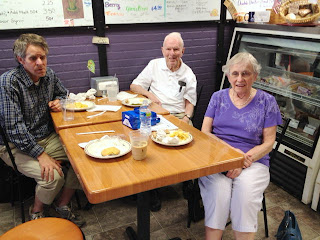Armchair Adventures
published July 15, 2012
by Paul Sullivan
The Rich History of Kilkenny
On the
morning of our third day in Dublin,
my son, Tim, and I headed out of the city, intent on getting a glimpse of the Ireland
we had come for.
As so many
cities have, this one had a 'beltway' to navigate but with a novel twist: tolls
for using it were to be paid at service stations along radial freeways
streaming outwards of Dublin. It
worked through a series of computer-controlled cameras snapping images of every
license on the toll road.
If we had
gone to Ireland
for the narrow, winding country lanes, this 21st-century techno-stuff
disappointed. Yet, as we would soon discover, that high-tech gimmickry soon
disappeared.
We would
revel in many drives down narrow winding ways in the next few days. All that's
needed to find them is to take the off-ramps into the past, down countless
Irish lanes that even today are little more than paved paths for pony carts.
That easy,
unstrained joining of ancient and contemporary is one of the country's most
engaging features. And the Irish themselves seem entirely at ease with this.
Our
immediate destination was Kilkenny, in the country's central southwest region
in the county of the same name.
Kilkenny's
popularity as a tourist destination may stem from its appearance as the
quintessential small Irish medieval city. Once we managed to deal with and work
around the crowds it was a wonderful town, full of scenic cathedrals, friendly
locals, pleasant little shops and all of it crowned by that architectural and
historic masterpiece, Kilkenny Castle.
The castle
sits high atop a bluff overlooking the River Nore and the city's commercial
core, itself appropriately aged to support the more prominent structures.
We saved
the serious sightseeing for the next morning and set off along John
Street (could be called Pub
Street) in search for food and lodging. We
discovered the latter at a small B&B down an alleyway. If there is an Irish
pub that doesn't serve decent food, we did not come across it.
The choices
seemed innumerable. We opted for a friendly place, nearly deserted, at the
north end of John Street.
It may have been for the service, as the young woman there could put a smile on
anyone's face.
Starved for
food and news, we snagged a good deal on both and for stateside news, she bid
me go behind the bar and use the computer. And the old news hound did just
that, logging onto the New York Times to read headlines about the Supreme Court
health care ruling. The 21st century certainly has its advantages!
By the way,
to continue momentarily along this line of digression, I do believe free Wi-Fi
was, if anything, more widely available in Ireland
than in most American towns I've been to. Got a smart phone? Don't travel without
it, but be sure to bring the right charging adapter.
Friday
dawned gray and drizzling. We donned rain gear and headed for St.
John's Bridge and Kilkenny
Castle. Begun in the 9th century,
this enormous building, like so many others, was not built over night. Instead,
these Irish castles seem to go through a series of lives, expanding, being
partially destroyed in some war or other, changing purposes and owning families
over centuries.
Not all
guidebooks give you the straight scoop on these things. One reports that this
stalwart stone eminence dates to the 12th century, but a guide told us where we
could peer through a glass floor at a floodlighted section of a stone
foundation dating to the 800s.
But for
practical purposes, most of the castle as it is seen today dates to the 17th
century, when it was home to the Butler
family, who ruled some 90,000 acres of surrounding Ireland
and-essentially owned those who rented it for farmland. This, by the way, from
some of the best informed guides I've ever run into. Tim and I talked to three
of these historians separately, at length.
And these
were historians, carefully linking eras of British history from centuries past
to the present. It was fun asking them to fit the fictional story of NPR's
popular Downtown Abbey into the narrative of this castle and others like it.
Nowhere in the
Irish Republic
are you likely to forget that the English ruled this land with an iron and
often scornful hand for many lifetimes. It took little Ireland
until 1923 to win the independence that we had won a century-and-a-half
earlier.
To this
day, the Irish seem very fond of Americans. After all, in the great potato
famine of 1847-49 and thereabouts, it is believed that a million Irish died and
an equal number fled their homeland, most of them to America-an
unthinkable toll for a small country.
And just as
Americans know from generational memories of their own Civil War, the Irish
will long remember the famine and the generations they spent struggling for independence.
-----------------------------


